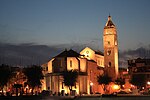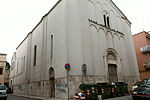Province of Barletta-Andria-Trani
Province of Barletta-Andria-TraniProvinces of Italy

The Province of Barletta-Andria-Trani is a province of Italy in the Apulia region. The establishment of the province took effect in June 2009, and Andria was appointed as its seat of government on 21 May 2010.It was created from 10 municipalities (comuni), which were formerly in the provinces of Bari and Foggia, taking its name from the three cities which share the new province's administrative functions. The total population of the 10 municipalities comprising the new province was 383,018 at the 2001 census.
Excerpt from the Wikipedia article Province of Barletta-Andria-Trani (License: CC BY-SA 3.0, Authors, Images).Province of Barletta-Andria-Trani
Via Ferdinando Chieffi, Barletta
Geographical coordinates (GPS) Address Nearby Places Show on map
Geographical coordinates (GPS)
| Latitude | Longitude |
|---|---|
| N 41.316666666667 ° | E 16.283333333333 ° |
Address
Via Ferdinando Chieffi
Via Ferdinando Chieffi
76121 Barletta
Apulia, Italy
Open on Google Maps









